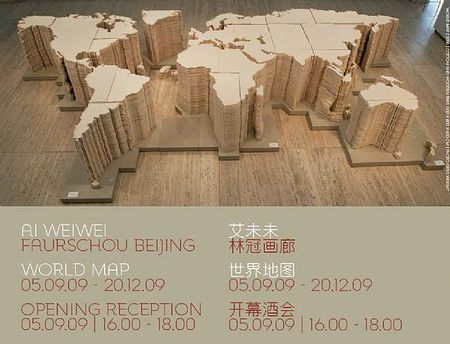Ai Weiwei 'World map' @ Galleri Faurschou, Beijing
In the fall Faurschou Beijing will be hosting a solo show with internationally acclaimed artist Ai Weiwei.
Politically frank and aesthetically poignant, Ai Weiwei's works deal with Chinese history and contemporary society. His formal practice changes in form and the materials deployed according to the diversity of activities his art embraces. Influenced early in his career by Dada, Duchamp, Jasper Johns, and Andy Warhol, Ai Weiwei's works have been based on a conceptual approach - on installation and sculpture.
The socio-political and economic climate of contemporary China most often serves as starting point for Ai Weiwei's art, and he uses local materials and resources like reclaimed wood from traditional Chinese houses and temples; Chinese antiquities like Neolithic vases and Qing Dynasty furniture; porcelain from the imperial kilns in Jingdezhen, freshwater pearls, bricks, tea, marble, stone and bamboo.
Despite this there is nothing "Chinoise" about his works; rather his international formal approach often makes use of metaphoric references, humour, puns, and political irony, that redefines and reconsiders the meaning of the traditional into something new - from traditional antique into seductive and thought provoking contemporary art, from convention to transgression.
The title work of the show World Map is a large map of the world made of thin layers of cotton. China is the world's largest producer of cotton, and also the world's largest importer and consumer of cotton. With China as the world's major producer of garment and textile - the piece is obviously a commentary to China's importance in global trade, but very typical for Ai Weiwei, the socio-political framework for the piece is always governed by strong formal aesthetics - here the beautiful soft white cotton, making the piece very poetic and subtle in its contents.
In the vein of Joseph Beuys another piece in the show, Fairytale, could be termed a "social sculpture". Ai Weiwei conceived it for Documenta in 2007, where he brought 1001 Chinese nationals to the relatively small town of Kassel, the home town of the Brothers Grimm. Many of the Chinese participants were experiencing their first trip abroad, and Ai Weiwei provided them all with luggage, various accessories and created a temporary living environment that included dormitory-style sleeping quarters.
This intervention in the city life of Kassel of so many Chinese at one time directly plays on our concepts of Socialist China and the mass unity associated with socialism, emphasizing the group over the individual. For Ai Weiwei though - the fundamental force for change is the individual experience, and the notion that through individual action, change is possible.
He believes all activities or art works should be social - and political. He has often been involved in collaborations, among others in his large scale architectural projects. For him it is important to engage in debates and to exchange experiences.
In the 1970's and 1980's Ai Weiwei was a protagonist in a dynamic avant-garde movement in China where a lot of activity saw its light on the Chinese art scene.
Ai Weiwei's career has steadily been gaining momentum in the past decades, not least due to his controversial exhibition "Fuck Off" in connection to the Shanghai Bienniale in 2000, his participation at Documenta 2007, and recently his design of "Bird's Nest", the Olympic Stadium in Beijing, built in collaboration with Herzog & de Meuron. Ai Weiwei is today one of the leading Chinese artists and we are very pleased to host this show - his first in the 798 Art District.
September 5 - December 20, 2009. Galleri Faurschou www.faurschou.com

/https%3A%2F%2Fprofilepics.canalblog.com%2Fprofilepics%2F1%2F0%2F100183.jpg)
/https%3A%2F%2Fstorage.canalblog.com%2F03%2F02%2F119589%2F96711876_o.jpg)
/https%3A%2F%2Fstorage.canalblog.com%2F11%2F31%2F119589%2F94773502_o.jpg)
/https%3A%2F%2Fstorage.canalblog.com%2F20%2F83%2F119589%2F94772815_o.jpg)
/https%3A%2F%2Fstorage.canalblog.com%2F26%2F72%2F119589%2F75604929_o.jpg)
/https%3A%2F%2Fstorage.canalblog.com%2F59%2F60%2F119589%2F26458628_o.jpg)



/http%3A%2F%2Fstorage.canalblog.com%2F90%2F99%2F119589%2F112019528_o.jpg)
/http%3A%2F%2Fstorage.canalblog.com%2F87%2F61%2F119589%2F112018204_o.jpg)
/http%3A%2F%2Fstorage.canalblog.com%2F96%2F54%2F119589%2F112017925_o.jpg)
/http%3A%2F%2Fstorage.canalblog.com%2F37%2F63%2F119589%2F111676516_o.jpg)